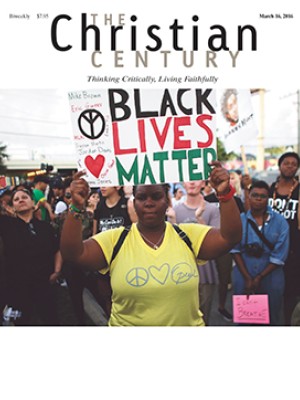Healing from the ground up: The church as field hospital

"What kind of church do you dream of?” This was the question to which Pope Francis was responding when he famously likened the church—at least the church he would like to see—to a field hospital.
“I see clearly,” Francis said, “that the thing the church needs most today is the ability to heal wounds and to warm the hearts of the faithful; it needs nearness, proximity. I see the church as a field hospital after battle. It is useless to ask a seriously injured person if he has high cholesterol and about the level of his blood sugars! You have to heal his wounds. Then we can talk about everything else. Heal the wounds, heal the wounds. And you have to start from the ground up.”
The pope could have answered the question about his dream church with an idealized portrait of the institution, but immediately he turned to the overwhelming reality of suffering; the ideal church is a wounded church, one where wounds are acknowledged first, and the acknowledgment itself begins the healing. Nearness, proximity to wounds—that is where the church needs to be found. The battle rages—all is not well with the world. But rather than condemn the evils of the world from a position of superiority, the church needs to be on the battlefield, not as a participant in the bloodletting but as the medical corps that risks its safety and its very life to bind up the wounds inflicted in the battle.
Read our latest issue or browse back issues.
It is possible that the pope meant the metaphor of battle in a purely spiritual sense. He goes on to explain the reference to cholesterol and blood sugars in terms of “small things,” “small-minded rules” that have to do primarily with the Catholic Church hierarchy’s emphasis on a few sexual issues to the neglect of more central matters. By way of contrast, the pope offers that “the most important thing is the first proclamation: Jesus Christ has saved you.”
Salvation, however, is not just something for the spirit; we are bodily creatures, and Pope Francis has put those who are materially poor at the center of his ministry. When he says that the church needs to heal wounds and warm hearts, he is addressing both the body and the soul, the exterior and the interior, of the human person, and addressing both those who suffer material deprivation and those who suffer spiritual deprivation. The two are inherently related.
As Francis has made clear in his fierce denunciations of the “economy [that] kills” (Evangelii gaudium), the exclusion of a billion people from access to a dignified subsistence is directly related to the sickness of spirit that worships at the altar of capital. The “idolatry of money” is both a material and a spiritual wound. Francis asks: “How can it be that it is not a news item when an elderly homeless person dies of exposure, but it is news when the stock market loses two points?”
The church that I dream of is one that helps heal wounds both spiritual and material, a church that does not remain confined to the ambit of “religion” but, as in Pope Francis’s metaphor, goes out onto the field of battle, not to kill and maim but to bind up wounds. The church in this image is a hospital, an organization of people for a specific healing purpose. Francis dreams not merely of individual Christians going out into the world to help; “it would be wrong to see [the church’s mission] as a heroic individual undertaking, for it is first and foremost the Lord’s work, surpassing anything which we can see and understand.”
The church is not a collection of individuals, not even just an organization, but an organism. The church is in fact not an “it” but a “we,” a living subject, united to Christ our head, a body of people that brings many individual persons together, binding wounds precisely in binding people to one another in mutual care and love. For the same reason, the church is not the hierarchy but all of us. You have to start, as Francis says, from the ground up. And like any good hospital, the church attempts to heal all those looking for healing, Christian or not.
The church, though, is not just a hospital but a field hospital. Unlike a stationary institution that occupies a certain territory and defends it against encroachment, a field hospital is mobile, an event more than an institution. A field hospital is unconcerned about defending its own prerogatives and instead goes outside of itself to respond to an emergency. As a body, it is visible, but it does not claim its own territory; its event-like character creates spaces of healing. It neither withdraws from the world, sect-like, nor resigns itself to the world as it is. It is not confined to working within the given political and economic structures of the world, nor is it concerned primarily with gaining influence among the powerful in order to change the world from above.
The approach is from below. As Francis has written in Evangelii gaudium, “an evangelizing community gets involved by word and deed in people’s daily lives; it bridges distances, it is willing to abase itself if necessary, and it embraces human life, touching the suffering flesh of Christ in others.” This church is not a “player” in the game of the powerful. “I prefer a Church which is bruised, hurting and dirty because it has been out on the streets, rather than a Church which is unhealthy from being confined and from clinging to its own security. I do not want a Church concerned with being at the center and which then ends by being caught up in a web of obsessions and procedures.”
The image of the church as field hospital is important because it is dynamic and therefore helps to confound one of the standard dualities used to discuss the church’s social engagement: the church either engages with “culture” and “the world” or withdraws from them. The image of the church as field hospital makes clear that the church cannot retreat into enclaves but must go out and heal wounds.
Real sectarians, however, are much rarer than the charge of sectarianism, which is often used to dismiss even deeply committed activists like Dorothy Day and her followers because their critique of the state goes deeper than merely trying to manage its ill effects. Those who make the charge of sectarianism regard the refusal to do violence on behalf of the nation-state as a form of irresponsible withdrawal.
The image of field hospital, on the other hand, puts the burden of proof on those who would inflict wounds rather than heal them. It also opens the possibility that the church’s action on the social and political field of battle could be something more creative than simply lending its support to one or the other of the combatants.
In the United States, the church’s political imagination is often limited to throwing its dwindling weight behind Democratic or Republican initiatives, in pursuit of a liberal or conservative legislative agenda. Absent is any deeper critique of social, political, and economic institutions and the attempt to imagine and enact new and more humane types of social, political, and economic practices. The image of field hospital pictures the church not simply lobbying but taking risks, refusing to accept the political system or the economy as is, but rather creating new mobile and improvised spaces where different kinds of politics or economic practices can take root.
I am often lumped in with a variously defined group of “radical” Christian thinkers who, though prophetic and inspiring, fail to appreciate the goodness of nature and so turn their backs on participation in the world’s given structures, preferring to huddle together in small, perfectionist sects of like-minded Christians. The choice before us is considerably more complex than the rejection or embrace of “the world,” given that Catholic social thought uses the term world in at least four different senses. And there is no one economy to either embrace or shun, but rather a plurality of economies that express deeply embedded theological commitments. Refusing to accept that the dreary choice between two corporate-sponsored political parties is all that is meant by “politics” is not thereby to refuse participation in politics, nor is it a rejection of democracy. Indeed, I advocate Christian experiments in forms of democracy that involve a much more significant commitment to politics than punching a few chads every four years.
The goal of the church is not to stand apart from the rest of the culture for the sake of being different. Dorothy Day, for example, did not advocate nonviolence as a way of separating a perfectionist elite from the sinful world. On the contrary, her nonviolence stemmed from a deep sense of solidarity with all of humanity, united in the mystical body of Christ. This solidarity not only made it unthinkable to attack a member of one’s own body. It also meant that the guilt for the sin that drove the violence was spread throughout the body and shared by all. Day refused the temptation to use violence not from a sense of purity but from a sense that we are not good enough to use violence well.
I dream of a merciful church with the courage to be eccentric, a church that, in the words of Pope Francis, is “to go forth from our own comfort zone in order to reach all the ‘peripheries’ in need of the light of the Gospel.”
This essay is adapted from William T. Cavanaugh's book Field Hospital: The Church’s Engagement with a Wounded World (Eerdmans).





